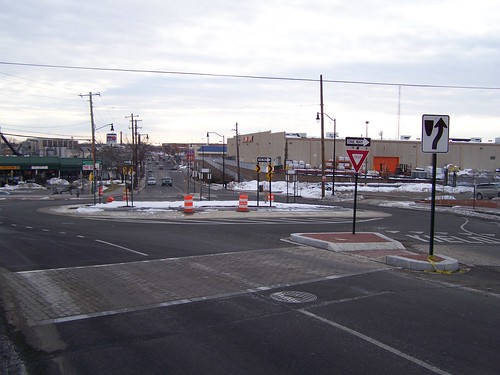Are roundabouts an urban or suburban technology?
(The program sure is "neoliberal" in how it stresses technological solutions and the negatives of regulation. And there sure isn't much opportunity to delve very deeply into any of the issues presented) One of the people presenting at the Post conference is talking about the time wasted by queuing at intersections. He lives in a smaller town.
He suggests that compared to traditional intersections, roundabouts work better in terms of faster throughput and increased safety. Roundabouts are intersections that are made into circles, where for the most part, entry roads into the circle are not signed or signalized or are signed with yield signs.
In DC, we have both traffic circles and roundabouts. Traffic circles are not roundabouts because they have traffic signals. Examples of a traffic circle would include Dupont Circle, Chevy Chase Circle, Washington Circle, Logan Circle, or Thomas Circle.

Sherman Circle, Washington, DC
Roundabouts that you think are traffic circles but isn't because there aren't traffic signals, only yield or stop signs, are Grant Circle and Sherman Circle in the Petworth neighborhood. There is a more true "roundabout" in terms of size on Brentwood Road NE.

Brentwood Road NE roundabout
I use these roundabouts regularly and as a pedestrian and cyclist, I find that roundabouts are designed to prioritize vehicular traffic rather than to balance the needs of pedestrians and cyclists with the desire of motor vehicle operators to move quickly.
I rarely feel comfortable going into a circle as a bicyclist because most of the motor vehicle operators don't signalize if they are turning, and in terms of entry, often I have to move to the leftmost part of a lane to ward off traffic coming behind me.
NotionsCapital calls our attention to a couple pieces on the topic, "They're Small But Powerful," from the FHWA magazine Public Roads, and "Evaluating pedestrian and bicyclist risk in Minnesota roundabouts" from the University of Minnesota Center for Transportation Studies (which is a great resource).
The UMN study finds that all is not peachy for pedestrians and cyclists with roundabouts, although the study city in the City of Minneapolis had a greater rate of vehicles yielding to pedestrians and cyclists compared to the suburban site. From the article:
The research team identified several factors that influence drivers’ yielding behavior. Study results indicate the following trends:
- Drivers are more likely to yield to pedestrians or bicyclists beginning their crossing in the center island.
- Vehicles exiting the roundabout are less likely to yield than those entering it.
- Drivers are more likely to yield to larger groups.
- Vehicles entering the roundabout at the immediate upstream entrance are more likely to yield than those coming from other entrances.
- Drivers are less likely to yield if they encounter another vehicle merging into the roundabout immediately before the exit where the pedestrian is trying to cross.
- Yielding probability decreases with more vehicles present in the roundabout.
Note that the Florida DOT report Roundabouts and Access Management has a review of the literature that goes beyond the above-cited publications.
Labels: roads, traffic engineering, traffic safety and enforcement, transportation planning, urban design/placemaking



2 Comments:
The safety of a pedestrian crossing any road, regardless of the intersection control, can be enhanced in many different ways. Signing and marking the crossing is usually the first step. Shortening the crossing distance is another. The safest shortening method is a median that permits pedestrians to cross one direction of traffic at a time (two-phase), like at a modern roundabout. This is particularly helpful for the youngest and oldest pedestrians. Enhanced markings include advance stop bars where any half of the crossing has more than one lane. This helps reduce the double-threat collisions on multi-lane crossings. Raised crossings slow traffic right were pedestrians cross. If emergency access is a concern, placement of speed cushions in advance of the crossing are a solution. Electronic warnings, like rapid flash beacons, increase motorists’ awareness of pedestrian activity. Hybrid beacons (with a red indication) or full signals are usually reserved for locations with the busiest traffic or pedestrian uses (due to cost). One advantage of beacons is they usually rest in off, so auto traffic is only delayed when pedestrians need the extra help crossing. With a menu of ways to improve crossing safety, choosing the best one depends on local conditions. However, each of these options is moot if there are not laws in place, or enforced, to clearly identify who has the right of way to begin with.
Thank you for providing such a valuable information and thanks for sharing this matter. to get Online pharmacy from online medicine store.
Post a Comment
<< Home